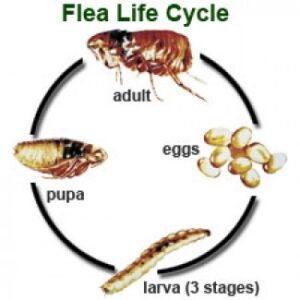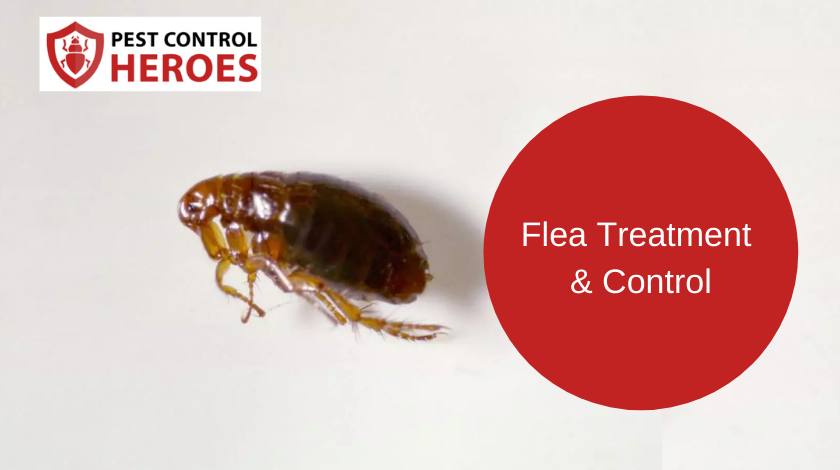There are many home remedies for flea treatment and control such as a flea bomb available through supermarkets, hardware stores or online that can have a positive effect on getting rid of fleas in your house and garden and on your pet. There are also many products out there that don’t work and the end result is a waste of time, money, more flea bites and more fleas.
How to get rid of fleas in your house successfully will take a combined approach through professional flea treatment, animal treatment and thorough housekeeping. It is important to take charge of any flea infestation as soon as it is noticed. An untreated flea infestation does not simply go away, the problem just gets bigger.
- Your house, yard and pets will all need to be treated on the same day.
- Animal flea treatments need to be effective so consulting with your vet beforehand for the best flea control for your dog is recommended.
- Your house will need to be thoroughly vacuumed & mopped and your lawn will need to be mowed short. All grass clippings and vacuuming will need to go directly into your outside bin.
- All animal bedding will need to be thoroughly washed and possibly treated.
- Instructions for after treatment will also need to be adhered.
Advice for Post Professional Flea Treatment
Be patient! Even if your flea treatment has been done correctly, you will still see newly hatched fleas, usually for several weeks. Do not leave flea infested areas undisturbed – movement hatches fleas. If the flea treatments are working, fleas will hatch, contact the treated surface and die within a few hours.
Warning: Not all pest controllers offer the same sort of flea treatments. How to get rid of fleas methods employed, how much product is applied & the types of products that are used are all factors. If you are concerned about an infestation be sure to ask your pest controller about what is involved in the flea treatment, will the eggs also be completely eradicated and if there are any guarantees of the workmanship involved.
Flea control measures usually involve fast-acting fumigants to kill adult fleas and insect growth regulators which interfere with the moulting process in larval fleas, preventing them from reaching adulthood. The active ingredient, pyrethrin is considered a natural flea control product as it is a derivative of the chrysanthemum, the pesticidal properties have been utilised for centuries.
Flea Facts
What do Fleas look like?
Fleas are tiny, approximately 2.5 mm in length, with females slightly larger than the males. Their bodies are brown, ranging from very dark to golden in colour. They are laterally compressed (meaning they are tall and skinny) and are covered with spines and hairs that angle backwards.
These features help them weave their way effortlessly through the thick hair of their hosts. Fleas have long, spiky legs that are used for jumping to and from the animals they feed on.
How Do Fleas Breed? – Flea Life Cycle.
 The flea life cycle is a complete lifecycle much like a butterfly, consisting of an egg, larva, pupa and adult stage. The female scatters her tiny eggs on the floor or bedding where the host rests. She may also deposit eggs directly on the host, although the majority fall off and onto the ground as the animal shakes or scratches.
The flea life cycle is a complete lifecycle much like a butterfly, consisting of an egg, larva, pupa and adult stage. The female scatters her tiny eggs on the floor or bedding where the host rests. She may also deposit eggs directly on the host, although the majority fall off and onto the ground as the animal shakes or scratches.
The eggs hatch after 48 hours and the tiny hatchling uses a special egg-tooth on its head to break through the shell (much like a bird does). The worm-like larvae take around 1 month to pupate, spinning a tiny cocoon made from silk and pieces of debris from the ground. These larvae move away from the light, burrowing down into the carpet, cracks in floorboards or into the soil. They moult three times before forming a pupa. The pupa is sticky, so it binds its surroundings to itself, becoming invisible.
In summer, a flea may be ready to hatch from the pupa about 7-14 days after it is formed, however they can remain dormant for up to 18 months! Hatching of the flea from the pupa is triggered by nearby movement, predominantly during warm, moist weather conditions. The weight and warmth from the resting body of an animal will often trigger the adults to rapidly emerge from their cocoons.
After feeding on the host, the engorged female flea is ready to mate and lay eggs – about 24 hours after hatching. She is capable of laying up to 500 eggs (27 per day) over a lifetime which may span several weeks.
Where Do Fleas Live – Fleas in House & Yard
Fleas are pests of warm-blooded animals worldwide. As well as dogs and cats, fleas can feed on humans, rabbits, birds, rats, mice and even ferrets! The two main species that wreak havoc in our homes are the Cat Flea (Ctenocephalides felis) and the Dog Flea (Ctenocephalides canis). They are virtually identical to the naked eye and they have very similar life cycles. The main difference between them is their preferred hosts. The Cat Flea will readily bite cats, dogs, chickens and rats, while the Dog Flea is found on dogs and rabbits, but rarely on cats. Fleas themselves live on their warm-blooded hosts. As they scatter their eggs onto the ground or these are dispersed from the host to the ground they generally start out life in the carpet, the lounge suite, dog bedding and outside areas where the animals play and rest. The eggs will hatch in these areas and the fleas will attach themselves to the next host that walks by.
What Do Fleas Feed On?
Adult fleas feed primarily on the blood of their host. An average female will consume 15 times her own bodyweight of blood each day. Flea larvae do not drink blood from the host, instead of consuming organic matter such as dried blood, hair, skin flakes and the faeces of adult fleas from the floor & bedding where the host lives.
Flea bite – What do flea bites look like?
A flea bite on humans can generally be described as a round red area with a small darker red spot at the centre. It usually lasts for several hours with varying reactions. Sometimes it results in a slight itch while others with extreme allergies will sometimes break out into hives and excessive swelling. Flea bites on children are usually more severe in appearance and itchiness than adults due to their sensitive skins. Usually, the concentration of bites is at the ankles & lower legs.
Treating Flea Bites on Humans
See your doctor or pharmacist if the flea bites appear severe and cause allergic reactions. Other ways to reduce itchiness and redness are;
- Wash affected area with a mild antiseptic soap or detergent
- Put an ice pack over the area to assist with reducing swelling and inflammation
- Apply some calamine lotion or soothing gel to relieve the itch
Are Fleas Dangerous?
Fleas cause a great deal of annoyance and discomfort for our pets. And they have no problems with leaping off our furry friends and onto us! Their feeding behavior has several impacts on the health of us and our pets such as:
- Causing allergic reactions and skin conditions such as mange and dermatitis in dogs and cats
- Severe infestations on your pet can lead to hair loss and anemia
- They transmit cat and dog tapeworm
- They readily feed on humans, causing itchy red welts and discomfort
- Scratching welts can lead to secondary infections in both humans and animals
- Some animals and humans can have allergic reactions to the saliva of fleas
- They can transmit murine typhus; bubonic plague and the germs responsible for cat-scratch fever.
Flea prevention in the home and for your pets
Getting rid of Fleas isn’t the easiest of things so flea prevention is definitely worth the effort. Adult fleas are surprisingly tough given their tiny size. They can live for up to 20 days without feeding and can easily leap off their hosts if conditions become unfavourable (such as when you’re giving Fido a bath). It has been estimated that up to 80% of a household infestation is made up of flea eggs, larvae and cocoons – not just the adult fleas. The key is to eliminate food and shelter for the larvae, preventing them from maturing into blood-sucking adults. Try the following tips:
- Vacuum thoroughly and regularly to remove the dirt, hair and debris that makes up the diet of larval fleas.
- Vacuum to suck up eggs, larvae and cocoons. These tough little guys can continue to develop in the vacuum bag, so be sure to dispose of it when you’ve finished. Bag only half full? Try popping it in your freezer for a few days to kill any critters. Another tip is to put a flea collar in your vacuum bag.
- Regularly wash your pet’s bedding in hot water and dry in the sun.
- Be vigilant. Groom your pet regularly and look for signs of infection such as adult fleas, flea “dirt” (the dried blood & excrement), welts, hair loss and any biting or scratching behaviour.
- Fleas can enter your home on other animals such as rats and mice. Keep your lawn and garden clear of debris (where they may shelter), fix any holes or access points to your home and consider putting out traps or baits. Also, ask for the assistance of a rodent pest controller for effective treatments.
- Keep your pets flea-free by using control shampoos; flea collars or consult your vet for topical treatments such as Revolution or Advantage.
- Watch where you walk! Sensing your body heat and breath as you pass by, fleas will leap onto your shoes, socks and skin, hitch-hiking their way into your home unnoticed.
- A natural flea control method is also garlic! Fleas don’t like the smell so adding a couple of minced cloves to fiddo’s daily meal is a great deterrent for fleas as well as being good for your dogs’ overall health – just watch out for their breath!
Still, looking for ways on how to get rid of fleas? We can help! Our recommended technicians are always available and can discuss your flea situation with you before applying the best treatment. Drop us a message today and we’ll get right back to you with a true local pest hero near you.

